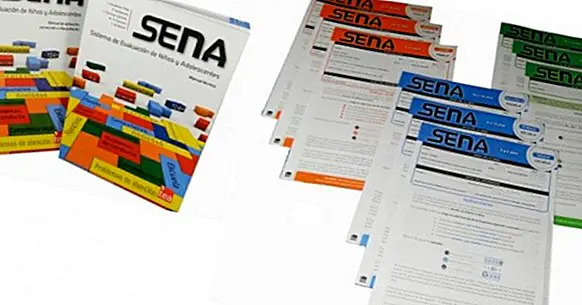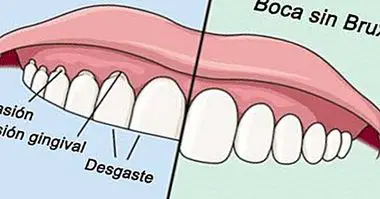SENA: an efficient clinical evaluation system for children and adolescents
With the constant evolution that intrinsically involves the knowledge of psychology, more and more complete assessment instruments are needed that allow the achievement of a more comprehensive assessment process. This is even more relevant in the case of the child population, where a process of psychological development is taking place that will be decisive in the later achievement of personality and adult functioning.
In this sense, the rise of multidimensional psychometric tests is becoming increasingly evident. This type of approach allows contemplating personal variations in the characteristics and manifestations of psychological problems. The Evaluation System for Children and Adolescents (SENA) is a good example of this type of methodology that has a series of features that greatly facilitate the role of the clinician in the evaluation of infant-juvenile psychopathology.
- You may be interested: "Anxiety disorders in childhood: symptoms and treatments
Description and application of SENA
SENA is oriented to evaluate the set of emotional and behavioral problems that can be observed between 3 and 18 years of age . Its publication in 2015 was a proposal to replace a very similar previous test, the BASC (System of Evaluation of the Conduct of Children and Adolescents) in order to update some of the elements included in the scales, increase the validity index of the test and complement with other scales of clinical interest, such as those related to Psychological Resources and Vulnerability Areas.
More specifically, the SENA presents three types of questionnaire based on the age of the person evaluated : children's education (3-6 years), primary education (6-12 years) and secondary education (12-18 years). It also has the particularity that each chronological section of the test is multi-informant, each consisting of three complementary questionnaires: the self-report, which collects the responses of the subject; the family report, answered by the parents; the school report, which includes the evaluation in the school environment observed by the child's tutor or also by the school psychologist.
What does SENA evaluate?
This instrument makes it possible to obtain, through different age-specific forms and informants, an exhaustive assessment to determine the existence and intensity of the emotional and behavioral problems most commonly associated with the child and adolescent population. So, more specifically SENA differentiates the following types of psychological difficulties .
Internalized problems
These are related to anxiogenic or dysphoric symptomatology and become more usually internal emotional manifestations of the individual.

Externalized problems
Its indicators can be externally more evident and are related to more behavioral aspects.

Contextual problems
These scales are shaped by the assessment of problems in the family and in the school environment (differentiating the academic difficulties of the relational from the peers).

Specific problems
Depending on the chronological mode administered, the existence of the following types of problems is evaluated:

All the aforementioned scales converge in obtaining global indexes that synthesize what is found in them and add a general value of difficulties in executive functions and the total level of personal resources.

On the other hand, SENA also provides other types of indexes with very relevant information that facilitate a deeper and more complete assessment of the personal dispositions of the evaluated person in order to establish more clearly if the problems found have a more or less favorable prognosis . These include scales of vulnerabilities or factors more linked to a worse prognosis and personal resources, which are understood as protective factors associated with a better prognosis.
On the other hand, the SENA highlights the presence of positive responses in critical items, the seriousness of which requires special attention to be paid to its more detailed analysis, such as questions about suicidal ideation, school bullying, hallucinations, etc.
Finally, this tool measures, by means of some control scales, the sincerity with which the informants have responded without minimizing, maximizing or manifesting an incoherent style in the answers provided. The scales included in this section refer to Inconsistency and Positive / Negative Printing of the answers provided.
- Maybe you're interested: "The 6 stages of childhood (physical and psychic development)"
Conclusion: purpose, reliability and validity of SENA
Like any psychometric psychological evaluation instrument, the SENA does not pretend to serve as the only diagnostic element . While it is true that it provides a large volume of information, everything found from this must be complemented with a good process of analysis and other methodologies such as observation, interview or the administration of other complementary tests. As a whole, this will allow a more clear diagnostic impression to be elaborated in a rigorous manner, as well as to outline the type of psychological intervention that is most appropriate to the case being evaluated.
Regarding the main indices that assess the quality of a psychological assessment instrument, the reliability (the degree to which the test is accurate in the variables it measures) and the validity (the safety with which the test measures the variable that you want to measure), satisfactory levels have been obtained in both areas.
Thus, the average obtained in all SENA scales has reached an internal consistency or reliability of 0.86 (values between 0.0 and 1.0). On the other hand, the level of agreement between informants is between 40 and 60%, which places SENA on the average of most evaluation instruments and even slightly higher depending on the source and the scale Clinic determined.
Finally, with regard to the validity of the test , the long process and the participation of a large group of experts who have intervened in the elaboration and review of the items that make up the test are a sample of the exhaustive work carried out to reach a satisfactory validity value.
Bibliographic references:
- Fernández-Pinto, I., Santamaría, P., Sánchez-Sánchez, F., Carrasco, M.A. and del Barrio, V. (2015) SENA. Evaluation System for Children and Adolescents: Application Manual, correction and interpretation. Madrid: TEA Editions.
- Fernández-Pinto, I., Santamaría, P., Sánchez-Sánchez, F., Carrasco, M.A. and del Barrio, V. (2015) SENA. System for the Evaluation of Children and Adolescents: Technical Manual. Madrid: TEA Editions.



















